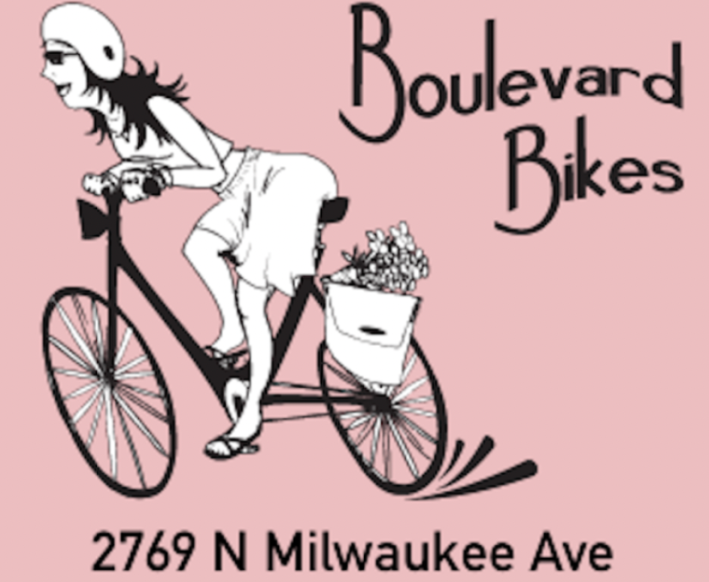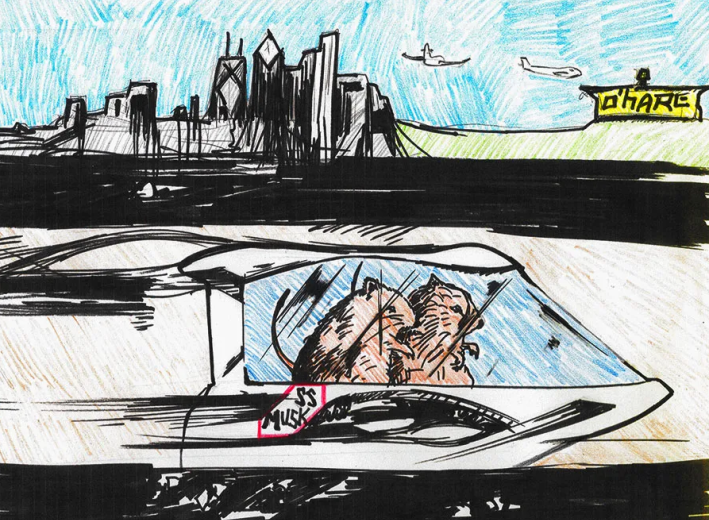
Update 12/27/24, 10:15 AM: As we predicted would happen, Chicago Tribune readers wrote letters to the editor, asking the editorial board for a correction to its piece implying recent protected bike lane installations on Elston and Milwaukee avenues "reduced... vehicular capacity," which is provably false, and cause traffic jams.
"The car lanes remain the same, and the bike lanes — bikes are vehicles! — are now inviting more bike traffic than before," wrote Chicagoan Amber Wilson. "Please consider updating the editorial to remove the error."
"Adding protected bike lanes to portions of Milwaukee and Elston avenues did not result in a reduction of car lanes," Chicago resident Anthony Johnson wrote. "Could the Tribune Editorial Board please issue a follow-up and correct this assertion?"
Your move, Chicago Tribune Editorial Board.
Update 12/22/24, 2:45 PM: Here's a Chicago Tribune editorial from last May with even more explicit misinformation about the protected bike lanes on Elston and Milwaukee avenues. In this piece, the editorial board stated that before the PBLs were installed, these streets "were mostly two lanes in either direction [and] have been narrowed to one each way."

Chicago Department of Transportation spokesperson Erica Schroeder recently told Streetsblog that "no travel lanes were converted or removed" on Elston or Milwaukee as part of the installation of protected bike lanes.
The Tribune needs to correct both editorials.
Update 12/20/24, 2:30 PM: The squeaky [bicycle] wheel gets the grease! Tribune Editorial Page Editor Chris Jones went almost two days without responding to my last email about this issue. But after I published this article and sent him the link, he replied about 20 minutes later. See an excerpt from his new response (I left out the harsher stuff) and my reply at the end of this post.
"A lie can travel halfway around the world while the truth is still putting on its [bike] shoes."
– Mark Twain, supposedly
I won't bother to fully unpack the recent Chicago Tribune editorial rant against the Kennedy Expressway rehab project, "Downtown Chicago paid too high a price for slowpoke, ill-conceived Kennedy Expressway construction." Choosing to drive to the Loop, in situations where you don't really need to, is its own punishment. So it's not really Streetsblog's role to commiserate with motorists who opt to do that, especially when everybody knows there's a major roadwork project going on.
But it's worth noting the Tribune doesn't mention that public transportation would be a viable alternative for many folks who are instead stewing in traffic jams on their way to "concerts, restaurants, ice skating, department stores" etc. In fact, the only time the article mentions transit at all is to complain that not enough DNC attendees took the temporary express Metra runs to get to the United Center. It's as if the editorial board members are unaware that the CTA Blue Line even exists.

Oh, and this piece in a historically right-leaning newspaper says something nice about Elon Musk. You know, the tech billionaire who failed to achieve his pipe dream of building high-speed "electric sled" service to O'Hare Airport, but succeeded in helping Donald Trump get reelected.

But what's really problematic about the Tribune editorial is this sentence. "Many of the former alternate routes [to avoid Kennedy traffic jams], such as Elston and Milwaukee avenues, have reduced their vehicular capacity by adding bike lanes," it states.
Sure, the statement used the old canard that people on bicycles, rather than folks in large, private metal boxes, are to blame for road congestion. And, of course, if the goal is to increase the number of people these roads can carry, bike lanes are more space-efficient than mixed-traffic lanes. According to the Chicago Department of Transportation, which builds the bikeways, 2,736 people bicycle through the Elston/Milwaukee intersection in River West on a typical day.

And the editorial board committed some word crimes here. Or did they intentionally write that these avenues have reduced their own car capacity by installing bikeways on themselves, in an example of magic realism?
"[Elston and Milwaukee] don’t offer any meaningful relief from a clogged expressway anymore," the editorial continues. "Few aldermen want to talk about that, but everyone who uses a car to get around town from time to time knows it’s true."
Except that the Tribune's claim that Elston and Milwaukee are more likely to jam up nowadays because the installation of protected bike lanes "reduced their [motor] vehicular capacity" isn't true.
The stretches of these two avenues where there are now PBLs have one mixed-traffic ("travel") lane in each direction. They also generally had one "car" lane in each direction before the protected lanes were installed. So there was no major reduction in motor vehicle capacity!

On Wednesday, I tried to politely explain that in an email to Tribune Editorial Page Editor Chris Jones. (OK, I did post a somewhat snarky tweet about the issue shortly before doing so.)
"While the protected bike lanes installations have involved narrowing the mixed-traffic lanes, and in some case converting car parking spaces, the motor vehicle capacity on these streets is generally still the same as it was before the installations: one lane in each direction," I told Jones. "Please see the attached Google Street View images to see what I’m talking about."

"While [the idea that the installing protected bike lanes on Elston and Milwaukee involved eliminating mixed-traffic lanes] is a widely held misconception, the Tribune needs to run a retraction to avoid amplifying this myth," I said.
"No retraction forthcoming," Jones replied curtly. "Always happy to get letters though."
Sure, it would be a good idea for other sustainable transportation advocates to submit a letter to the editor on this matter. Here's how to do it.
"Please explain," I responded to Jones. "How did the street redesign I illustrated 'reduce vehicular capacity,' other than making it harder for motorists to illegally pass other motorists on the right by driving in the bike lane?"
He didn't write back.
But on Wednesday, I got more evidence that the Tribune is in the wrong here. "You are correct," said CDOT Communications Director Erica Schroeder told me in response to my query. "The motor vehicle capacity on [Elston and Milwaukee] has remained generally the same after the installation of [protected] bike lanes because no travel lanes were converted or removed."

"As you noted, protected bike lanes were created by repurposing curb space, narrowing overly wide [mixed-traffic] lanes, or reallocating parking spaces," Schroeder added. "These streets have undergone transformations that have made them safer and more accessible for everyone – whether walking, biking, driving, or taking transit – without eliminating travel lanes for cars."
She suggested that people who have more questions about the layout of Milwaukee check out CDOT's info page on the corridor.
Regarding the Tribune's reaction to my critique, a key purpose of a news outlet is to accurately tell the story of what's happening in its coverage area. Occasionally, the publication will make errors. It happens to the best of us! But when that occurs, the appropriate thing to do is run a correction, apologize to your readers, and move on.
Unfortunately, by refusing to do this, Chris Jones has opted to make Chicagoland's largest-circulation newspaper look small. I'd expect such a response from one of our city's more disreputable and car-centric neighborhood newspapers. But witnessing Jones and the Tribune take the low road on this issue is rather sad.
Update 12/20/24, 2:30 PM: Jones's response to this article, and my reply
Here's an excerpt from Chris Jones' prompt email response after I sent him this article. "Everyone knows those two streets are now less vehicle capacious and thus slower, for the reason you said yourself," he wrote. "That doesn’t mean, and we did not say, that is bad. This was an editorial we wrote about the Kennedy. But it is obvious to anyone who drives on them. We just beg to differ."
Here's the bulk of what I wrote back. "As CDOT’s statement confirmed, your new statement, 'Those two streets are now less [motor] vehicle capacious,' that is, less capable of containing a great deal of motor vehicles, is still false. Those streets can still contain at least the same number of vehicles as before the protected bike lanes were installed, because they still have the same number of 'travel' lanes."
"But I agree that with you right-sizing the width of the of the travel lanes discourages speeding," I added. "In addition, the protected bike lanes make it more difficult to drive in the bikeway to illegally pass other drivers on the right. So we’re on the same page that the PBLs have made these streets safer."
[Here's what I replied regarding Jones' statement, "That doesn’t mean, and we did not say, that (the outcome of the protected bike lane installation) is bad."]
"Actually, the editorial does say that, because of the protected bike lanes, '[Elston and Milwaukee] don’t offer any meaningful relief from a clogged expressway anymore,' which would be bad – if it were true," I wrote Jones.
"But, again, it’s not true," I continued. "The fact is, when motorists don’t speed or drive erratically, less space is needed between vehicles to avoid crashes, which means you can fit more drivers on the same length of road."
"So, once again, the Tribune's claim that the protected bike lanes 'reduced… vehicular capacity' is false," I wrote. "On the contrary, they may have helped increase it."
"This is not a 'We just beg to differ' situation," I concluded. "The Tribune amplified a frustrating misconception about the protected bike lanes on Elston and Milwaukee, and is making a conscious decision not to correct its mistake. I predict you will be spanked pretty hard for this in the [Tribune's] letters section in the near future."
Here's how to submit a letter to the editor at the Tribune.
Read the Tribune editorial here, if you must.

Did you appreciate this post? Streetsblog Chicago is currently fundraising to help cover our 2025-26 budget. If you appreciate our reporting and advocacy on local sustainable transportation issues, please consider making a tax-deductible donation here. Thank you!





